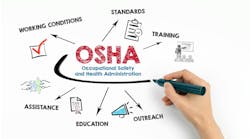OSHA reports that fall protection (1926.501) was the No. 1 most frequently cited standard in fiscal year 2022. In Part 2, we covered the first two subparagraphs cited under fall protection, and in Part 3, we covered the last three. But addressing the most frequent types of citations doesn’t mean you won’t get cited for something else. While fall protection citations refer to failures to meet the requirements of 1926.501, the larger body of fall protection information in the OSHA regulations consists of Subpart M. This includes:
- 1926.500. Scope, applications, and definitions.
- 1926.501. We covered the highlights of this in Parts 2 and 3 of this series.
- 1926.502. Fall protection systems criteria and practices.
- 1926.503. Training requirements.
- Appendix A. Determining roof widths — non-mandatory guidelines for complying with 1926.501(b)(10).
- Appendix B. Guardrail systems — non-mandatory guidelines for complying with 1926.502(b).
- Appendix C. Personal fall arrest systems — non-mandatory guidelines for complying with 1926.502(c).
- Appendix D. Positioning device systems — non-mandatory guidelines for complying with 1926.502(e).
- Appendix E. Sample fall protection plan — non-mandatory guidelines for complying with 1926.502(k).
This is quite a bit of reading to do, especially the appendices. But don’t throw your hands up in frustration. All of the information is organized and fairly easy to follow. The best way to go through it is to take a chunk at a time.
Before you start, center your mind on the reason for doing this. Sure, you want to avoid OSHA citations. But that crew you had coffee with yesterday? And the journeyman whose kid plays on your son’s soccer team? Ensuring your company’s fall protection policies protect them is the real goal. If you never get a citation, but there’s a fatal fall, the pain and loss experienced by everyone makes a fine look trivial.
Make sure to recenter your mind any time you run into any obstacle in addressing fall protection. The first obstacle you are likely to face is reading and understanding the definitions in 1926.500. But if you don’t know the difference between a buckle and a connector, then you need to overcome this obstacle.
A good way to become fluent in fall protection definitions is to relate each definition to something in the field. For example, obtain a connector and a buckle. Set them side by side. Now you’ll understand the difference. Not familiar with what a positioning device system is? Have a crew leader or similar person give you a demonstration.



